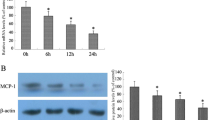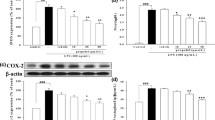Abstract
Purpose
Hypoxia-inducible factor 1 (HIF-1) is a master transcription factor of hypoxia-induced gene expression. Anesthetics and perioperative drugs have been reported to affect HIF-1 activity. However, the effect of propofol on HIF-1 activity is not well documented. In this study, we investigated the effect of propofol on HIF-1 activation using macrophage-differentiated THP-1 cells.
Methods
Cells were exposed to lipopolysaccharide (LPS) under 20 or 1% O2 conditions with or without propofol treatment. The cell lysate was subjected to Western blot analysis using anti-HIF-1α and HIF-1β antibodies. HIF-1-dependent gene expression was investigated by quantitative real-time reverse-transcriptase PCR analysis and luciferase assay. The amount of cellular lactate and ATP was assayed.
Results
Propofol suppressed HIF-1α protein accumulation induced by LPS, but not by hypoxia in the THP-1 cells in a dose-dependent manner by inhibiting the neo-synthesis of HIF-1α protein. Induction of the HIF-1 downstream gene expression including glucose transporter 1, enolase 1, lactate dehydrogenase A, pyruvate dehydrogenase kinase-1 and vascular endothelial growth factor was inhibited by propofol. Propofol suppressed LPS-induced lactate accumulation and ATP content in THP-1 cells.
Conclusion
Our experimental results indicate that propofol inhibits HIF-1 activation and downstream gene expression induced by LPS and suppressed HIF-1-dependent glucose metabolic reprogramming. HIF-1 suppression by propofol in macrophages may explain molecular mechanisms behind the inhibitory effect of propofol on cellular inflammatory responses.




Similar content being viewed by others
References
Sebel PS, Lowdon JD. Propofol: a new intravenous anesthetic. Anesthesiology. 1989;71:260–77.
Galley HF, Dubbels AM, Webster NR. The effect of midazolam and propofol on interleukin-8 from human polymorphonuclear leukocytes. Anesth Analg. 1998;86:1289–93.
Jawan B, Kao YH, Goto S, Pan MC, Lin YC, Hsu LW, et al. Propofol pretreatment attenuates LPS-induced granulocyte-macrophage colony-stimulating factor production in cultured hepatocytes by suppressing MAPK/ERK activity and NF-kappaB translocation. Toxicol Appl Pharmacol. 2008;229:362–73.
Chen RM, Wu CH, Chang HC, Wu GJ, Lin YL, Sheu JR, et al. Propofol suppresses macrophage functions and modulates mitochondrial membrane potential and cellular adenosine triphosphate synthesis. Anesthesiology. 2003;98:1178–85.
Hochachka PW, Buck LT, Doll CJ, Land SC. Unifying theory of hypoxia tolerance: molecular/metabolic defense and rescue mechanisms for surviving oxygen lack. Proc Natl Acad Sci USA. 1996;93:9493–8.
Semenza GL. HIF-1 and human disease: one highly involved factor. Genes Dev. 2000;14:1983–91.
Hirota K. Hypoxia-inducible factor 1, a master transcription factor of cellular hypoxic gene expression. J Anesth. 2002;16:150–9.
Wang GL, Jiang BH, Rue EA, Semenza GL. Hypoxia-inducible factor 1 is a basic-helix–loop-helix–PAS heterodimer regulated by cellular O2 tension. Proc Natl Acad Sci USA. 1995;92:5510–4.
Itoh T, Namba T, Fukuda K, Semenza GL, Hirota K. Reversible inhibition of hypoxia-inducible factor 1 activation by exposure of hypoxic cells to the volatile anesthetic halothane. FEBS Lett. 2001;509:225–9.
Nishi K, Hirota K, Takabuchi S, Oda S, Fukuda K, Adachi T, et al. The effect of local anesthetics on the cellular hypoxia-induced gene responses mediated by hypoxia-inducible factor 1. J Anesth. 2005;19:54–9.
Takabuchi S, Hirota K, Nishi K, Oda S, Oda T, Shingu K, et al. The inhibitory effect of sodium nitroprusside on HIF-1 activation is not dependent on nitric oxide-soluble guanylyl cyclase pathway. Biochem Biophys Res Commun. 2004;324:417–23.
Raphael J, Zuo Z, Abedat S, Beeri R, Gozal Y. Isoflurane preconditioning decreases myocardial infarction in rabbits via up-regulation of hypoxia inducible factor 1 that is mediated by mammalian target of rapamycin. Anesthesiology. 2008;108:415–25.
Li QF, Wang XR, Yang YW, Su DS. Up-regulation of hypoxia inducible factor 1alpha by isoflurane in Hep3B cells. Anesthesiology. 2006;105:1211–9.
Ma D, Lim T, Xu J, Tang H, Wan Y, Zhao H, et al. Xenon preconditioning protects against renal ischemic-reperfusion injury via HIF-1alpha activation. J Am Soc Nephrol. 2009;4:713–20.
Takabuchi S, Hirota K, Nishi K, Oda S, Oda T, Shingu K, et al. The intravenous anesthetic propofol inhibits hypoxia-inducible factor 1 activity in an oxygen tension-dependent manner. FEBS Lett. 2004;577:434–8.
Oda T, Hirota K, Nishi K, Takabuchi S, Oda S, Yamada H, et al. Activation of hypoxia-inducible factor 1 during macrophage differentiation. Am J Physiol Cell Physiol. 2006;291:C104–13.
Nishi K, Oda T, Takabuchi S, Oda S, Fukuda K, Adachi T, et al. LPS induces hypoxia-inducible factor 1 activation in macrophage-differentiated cells in a reactive oxygen species-dependent manner. Antioxid Redox Signal. 2008;10:983–96.
Oda S, Oda T, Nishi K, Takabuchi S, Wakamatsu T, Tanaka T, et al. Macrophage migration inhibitory factor activates hypoxia-inducible factor in a p53-dependent manner. PLoS ONE. 2008;3:e2215.
Hirota K, Semenza GL. Small GTPase protein Rac1 plays an essential role in hypoxia-inducible factor 1 activation in hypoxia. J Biol Chem. 2001;276:21166–72.
Kasuno K, Takabuchi S, Fukuda K, Kizaka-Kondoh S, Yodoi J, Adachi T, et al. Nitric oxide induces hypoxia-inducible factor 1 activation that is dependent on MAP kinase and phosphatidylinositol 3-kinase signaling. J Biol Chem. 2004;279:2550–8.
Kelly B, Hackett SF, Hirota K, Oshima Y, Cai Z, Berg-Dixon S, et al. Cell-type-specific regulation of angiogenic growth factor gene expression and induction of angiogenesis in non-ischemic tissue by a constitutively-active form of hypoxia-inducible factor 1. Circ Res. 2003;93:1074–81.
Cramer T, Yamanishi Y, Clausen BE, Forster I, Pawlinski R, Mackman N, et al. HIF-1alpha is essential for myeloid cell-mediated inflammation. Cell. 2003;112:645–57.
Vasileiou I, Xanthos T, Koudouna E, Perrea D, Klonaris C, Katsargyris A, et al. Propofol: a review of its non-anaesthetic effects. Eur J Pharmacol. 2009;605:1–8.
Chen RM, Chen TG, Chen TL, Lin LL, Chang CC, Chang HC, et al. Anti-inflammatory and antioxidative effects of propofol on lipopolysaccharide-activated macrophages. Ann N Y Acad Sci. 2005;1042:262–71.
Semenza GL. Oxygen-dependent regulation of mitochondrial respiration by hypoxia-inducible factor 1. Biochem J. 2007;405:1–9.
Wigfield SM, Winter SC, Giatromanolaki A, Taylor J, Koukourakis ML, Harris AL. PDK-1 regulates lactate production in hypoxia and is associated with poor prognosis in head and neck squamous cancer. Br J Cancer. 2008;98:1975–84.
Kim JW, Tchernyshyov I, Semenza GL, Dang CV. HIF-1-mediated expression of pyruvate dehydrogenase kinase: a metabolic switch required for cellular adaptation to hypoxia. Cell Metab. 2006;3:177–85.
Roche TE, Hiromasa Y. Pyruvate dehydrogenase kinase regulatory mechanisms and inhibition in treating diabetes, heart ischemia, and cancer. Cell Mol Life Sci. 2007;64:830–49.
Kim JW, Dang CV. Cancer’s molecular sweet tooth and the Warburg effect. Cancer Res. 2006;66:8927–30.
Peyssonnaux C, Cejudo-Martin P, Doedens A, Zinkernagel AS, Johnson RS, Nizet V. Cutting edge: essential role of hypoxia inducible factor-1alpha in development of lipopolysaccharide-induced sepsis. J Immunol. 2007;178:7516–9.
Acknowledgment
We thank Dr. Gregg L. Semenza for providing plasmids.
Author information
Authors and Affiliations
Corresponding author
About this article
Cite this article
Tanaka, T., Takabuchi, S., Nishi, K. et al. The intravenous anesthetic propofol inhibits lipopolysaccharide-induced hypoxia-inducible factor 1 activation and suppresses the glucose metabolism in macrophages. J Anesth 24, 54–60 (2010). https://doi.org/10.1007/s00540-009-0829-1
Received:
Accepted:
Published:
Issue Date:
DOI: https://doi.org/10.1007/s00540-009-0829-1




